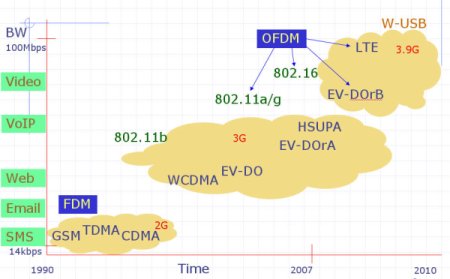
| Research Abstracts Home | CSAIL Digital Archive | Research Activities | CSAIL Home |
![]()

|
Research
Abstracts - 2007
|
From WiFi to WiMAX: Techniques for IP Reuse across Different OFDM ProtocolsMan C. Ng, Murali Vijayaraghavan, Nirav Dave, Gopal Raghavan, Jamey Hicks & ArvindIntroductionSince the early 1990's, there has been a rapid evolution in digital wireless protocols to enable higher data rates, improve bandwidth efficiency and offer services to more users. There is a dramatic shift from purely voice based services to high bit-rate data services to support web browsing, VoIP and high definition video. The underlying technology that enables this high data rate in non-line-of-sight environment is a modulation scheme known as Orthogonal Frequency Division Multiplexing (OFDM) [1]. OFDM has been around for several decades, but its robustness to multipath interference has been proven in practice by widespread deployment of 802.11a/g and ADSL. Since then, OFDM has become the most preferred modulation scheme for both broadband and high bit-rate digital wireless protocols, as shown in Figure 1. 
Figure 1. Evolution of Digital Wireless Protocols Although the components and overall structure of different OFDM protocols are functionally similar, the characteristics of the environment for which a wireless protocol is designed often result in different instatntiations of various components with different algorithmetic settings. It is in general difficult to develop IP blocks that can be reused across different protocols because the IP blocks developed are either not flexible enough to support the required algorithmetic settings or they have unnecessary logics to support unused algorithmetic settings. We demonstrate that it is possible to generate efficient hardware for two different wireless protocols, namely 802.11a [2] and 802.16 [3,4], from the same code base written in Bluespec SystemVerilog (BSV). The following two features are essential for such designs: 1) a polymorphic type system that permits highly parameterized codes and 2) the ability to compose independently created modules with predictable functionality and performance. The latter capability permits the refinement of individual modules to meet the performance objectives and exploration of area-performance tradeoffs without exacerbating the verification problem. Bluespec provides the unique capability of synthesizing such designs into efficient hardware. Parameterization in Bluespec has no cost because it results in no extra logic -- all the static parameterization is automatically removed by the compiler during the static elaboration phase of the compilation. MethodologyWe decompose a generic OFDM baseband transceiver into multiple well-defined blocks as shown in Figure 2. We focus on implementing highly-parameterized base-band processing blocks from which we can derive different instances to suppport multiple radio protocols. In our approach, only the transmitter and receiver controllers are protocol specific and non-reusable. 
Figure 2. Generic OFDM Baseband Transceiver Blocks We employ several techniques to enable significant module reuse and customization across different protocols, architectures, and design points. The high-level structure in which modules are interconnected follows a transaction-level modeling style [5]. Furthermore, we restrict communication between the modules to pass OFDM messages containing control and data values. The control part of the message is generated by the controller and is used to communicate to each module what is to be done with the data. The control part is not modified by any module as the message flows through the pipeline and is stripped off before the message leaves the base band processing section. The control part varies in type and value for different protocols; a challenge in coding reusable modules is to relate different (dynamic) control information to the different (static) instantiations of a module. Our solution to this problem is to ask the designer to pass a function parameter that explains how to extract the internal module control information from the external protocol specific control information when one instantiates a module. Progess and Future WorkWe have implemented a library of parameterized blocks and used them to implement the transceivers of 802.11a and 802.16. With our approach, 4028 lines of code are shared between the two transceivers which are over 90% of the total lines of code for each design. We have obtained the synthesis results for the two transceivers with Synopsis Design Compiler with the TSMC 180nm library. In [6], we show that our code is synthesizable into high quality hardware. In the future, we would like to evaluate if our library is rich enough to implement other ODFM protocols. Research SupportThis work is supported by Nokia. References:[1] R. W. Chang. Synthesis of Band-limited Orthogonal Signals for Multichannel Data Transmission. Bell System Technical Journal, 45:1775-1796, 1966. [2] IEEE. IEEE Std 802.11a-1999. Wireless LAN Medium Access Control (MAC) and Physical Layer (PHY) Specifications, 1999. [3] IEEE. IEEE Std 802.16-2004. Air Interface for Fixed Broadband Wireless Access Systems, 2004. [3] IEEE. IEEE Std 802.16e-2005. Air Interface for Fixed Broadband Wireless Access Systems. Amendment2., 2005. [5] T. Grotker, S. Liao, G. Martin and S. Swan. System Design with SystemC, chapter 8. Springer, 2002. [6] N. Dave, M. Pellauer, S. Gerding and Arvind. 802.11a Transmitter: A Case Study in Microarchitectural Exploration. In Proceedings of Formal Methods and Models for Codesign (MEMOCODE), ACM-IEEE, 2006. |
||||
|